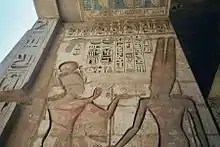Incense burner: arm (hieroglyph)
The ancient Egyptian Incense burner: arm is a horizontal hieroglyph representing various types of horizontal tools used to offer, and burn incense. In tomb scenes, it is sometimes depicted with a little cup-shaped box attached for keeping incense on the top surface; the person making the offering is occasionally seen holding an incense grain-pellet with lines of incense, or linked grains-in-a-line, which are equivalent to drifting smoke.
| Incense censer (horizontal, as ~arm) in hieroglyphs | ||
|---|---|---|
Incense was used from the beginning dynasties of Ancient Egypt.
The horizontal incense burner is a determinative in Egyptian language k3p, for "incense, to make smoke".[1] The phonetic value of the hieroglyph is kp.[2]

Egyptian Third Intermediate Period bronze incense burner
Incense burner: pot
| Common Incense Burner: Pot in hieroglyphs | ||
|---|---|---|
The other common type of hieroglyph for the burning of incense, is a small pot, with a flame, flickering from the top surface, "Incense burner: pot with smoke". The censer pot has one major usage in front of the feet of the "Soul" bird, the Ibis,
but is also replaced in rare instances with a meteor hieroglyph,[3]
, (not Gardiner listed).


 Censer arm artefact
Censer arm artefact Incense-smoke with "grains"-of-incense
Incense-smoke with "grains"-of-incense
See also
Wikimedia Commons has media related to Incense burner: arm.
Wikimedia Commons has media related to Incense burner: pot.
Wikimedia Commons has media related to Incense.
References
- Betrò, Hieroglyphics: The Writings of Ancient Egypt, "Incense burner", p. 215.
- Betrò, p. 215.
- Meteor hieroglyph, (Wikimedia Commons)
- Betrò, Maria Carmela. Hieroglyphics: The Writings of Ancient Egypt, c. 1995, 1996-(English), Abbeville Press Publishers, New York, London, Paris (hardcover, ISBN 0-7892-0232-8)
This article is issued from Wikipedia. The text is licensed under Creative Commons - Attribution - Sharealike. Additional terms may apply for the media files.